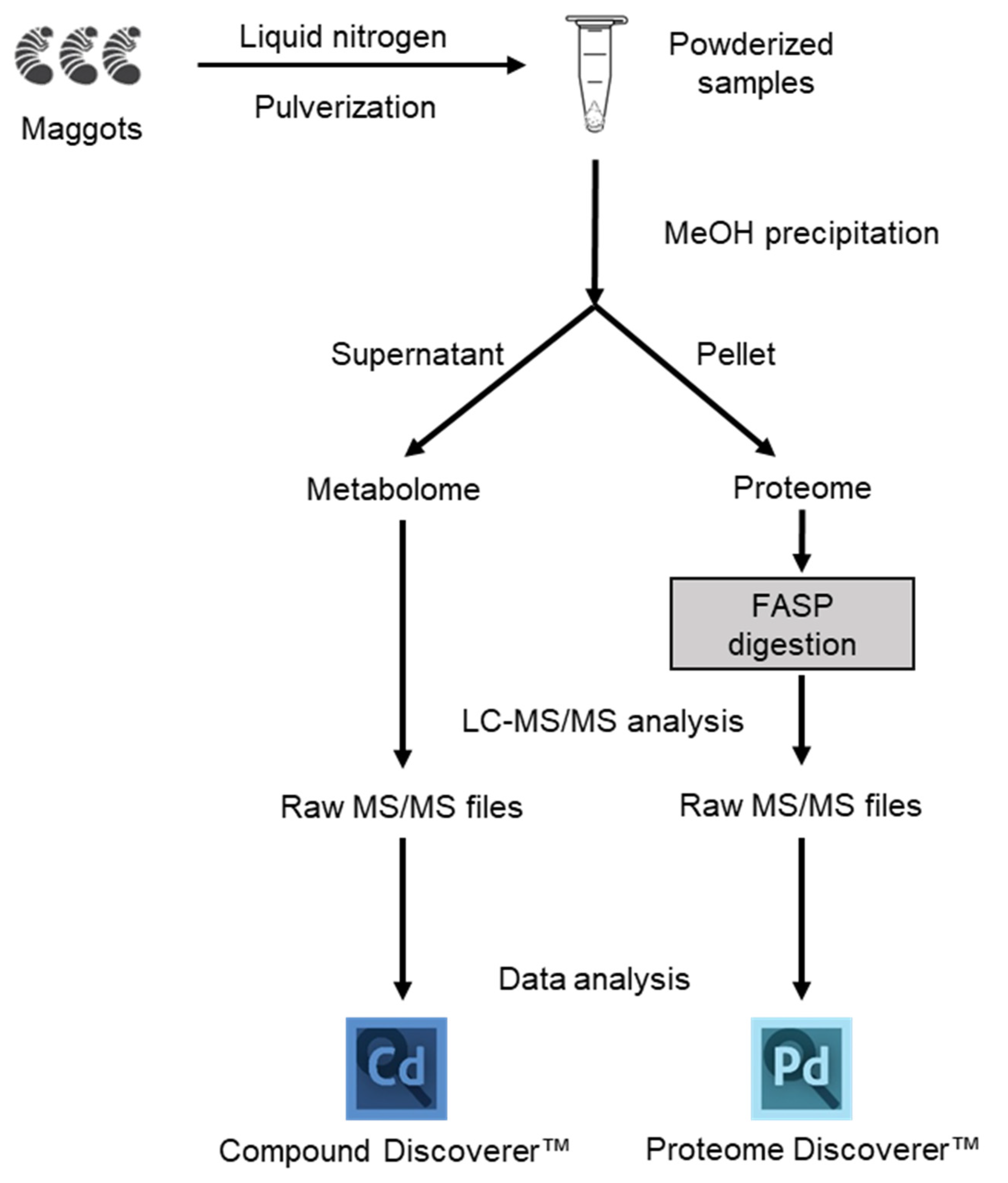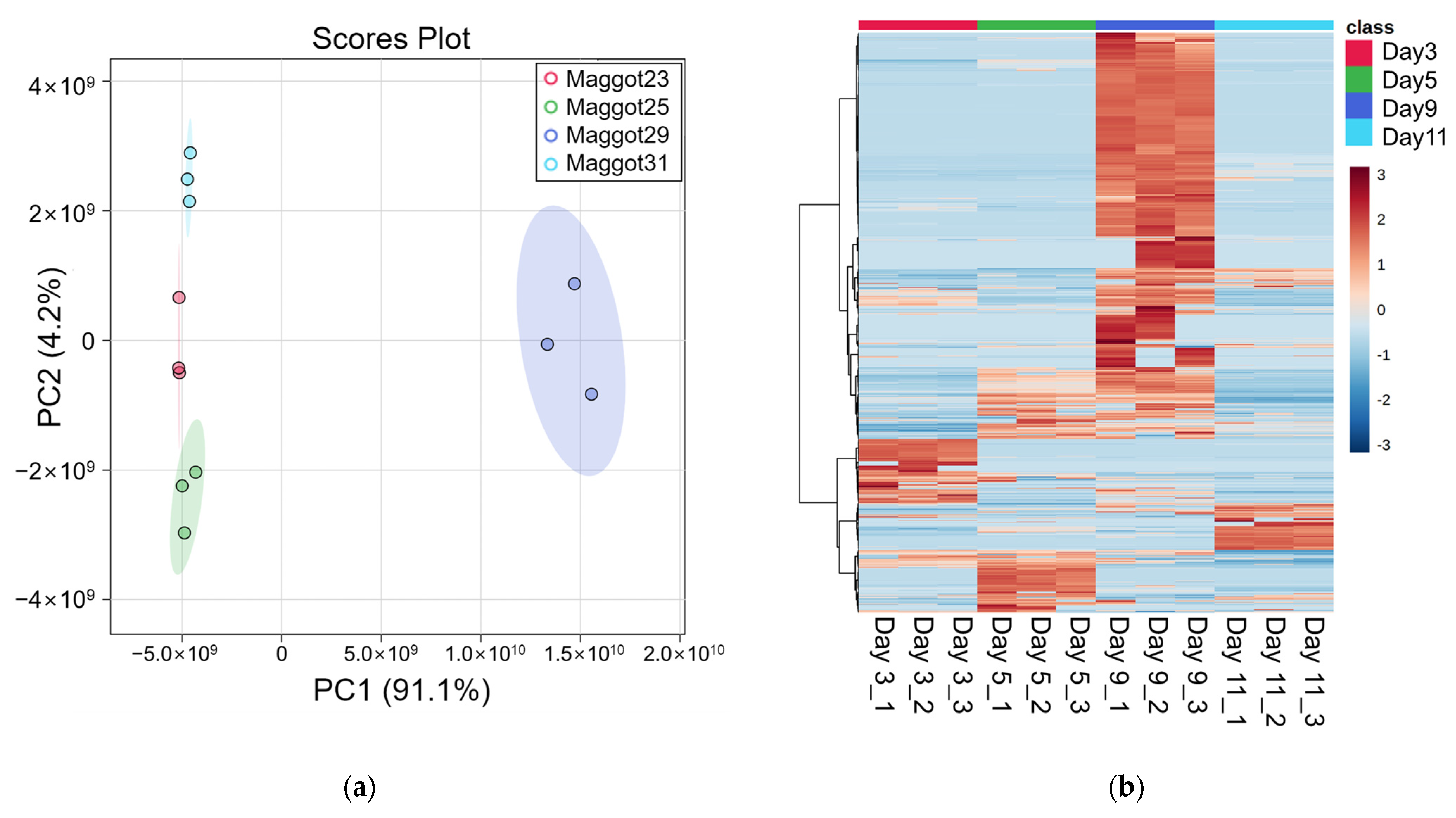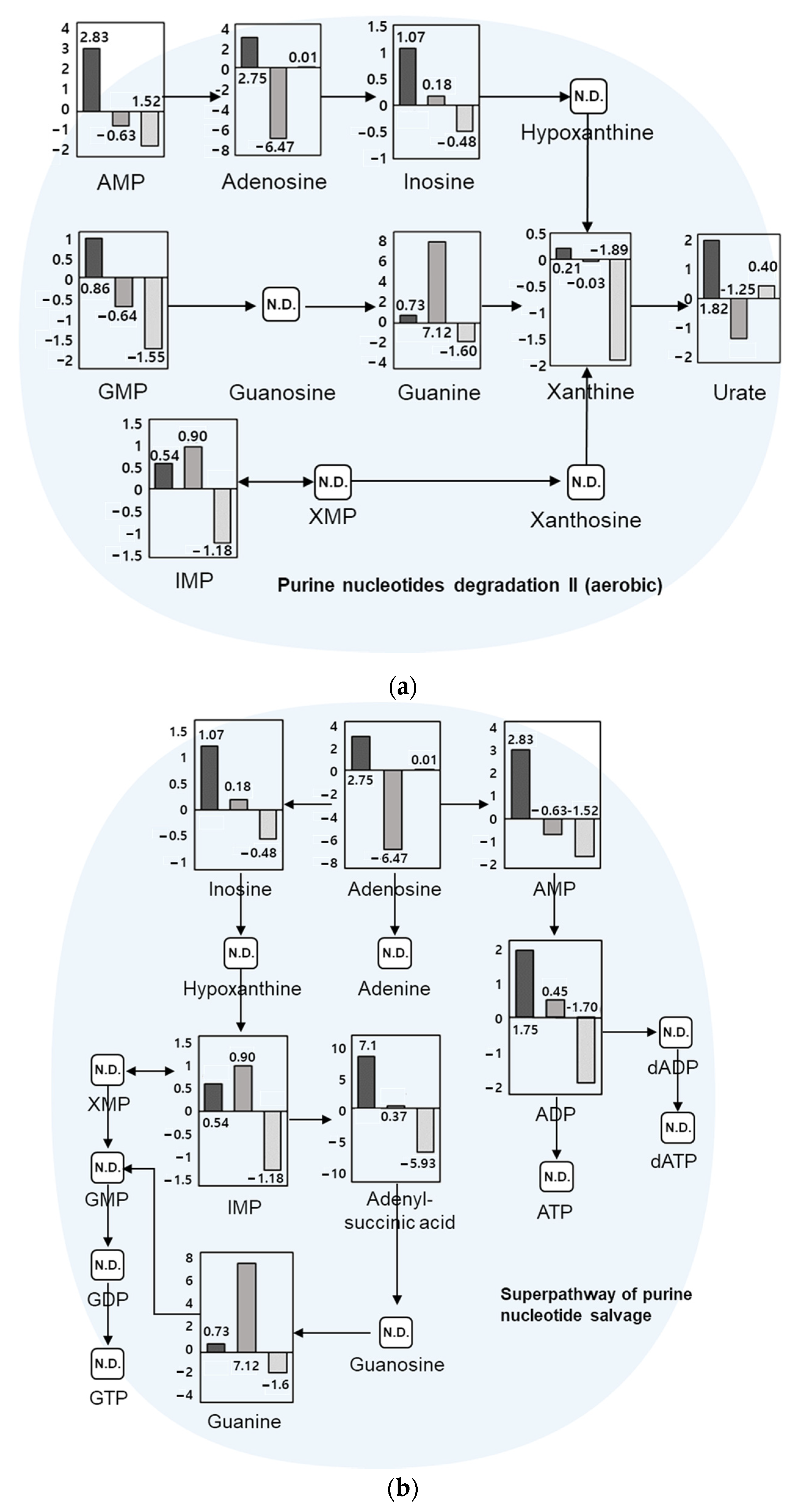Proteomic and Metabolomic Analyses of Maggots in Porcine Corpses for Post-Mortem Interval Estimation
Abstract
:1. Introduction
2. Materials and Methods
2.1. Materials
2.2. Experimental Design
2.3. Sample Preparation
2.3.1. Sample Collection
2.3.2. Sample Pretreatment
2.3.3. Extraction of Metabolites
2.3.4. Protein Digestion
2.4. LC-MS/MS Analyses of Metabolites and Proteins
2.4.1. Proteomic Analysis
2.4.2. Metabolomic Analysis
2.5. Data Analysis and Statistical Interpretation
2.5.1. Proteomics Data Analysis
2.5.2. Metabolomics Data Analysis
3. Results
3.1. Metabolomics
3.2. Proteomics
4. Discussion
5. Conclusions
Supplementary Materials
Author Contributions
Funding
Institutional Review Board Statement
Informed Consent Statement
Data Availability Statement
Conflicts of Interest
References
- Houck, M.M.; Siegel, J.A. Fundamentals of Forensic Science; Academic Press: Cambridge, MA, USA, 2009. [Google Scholar]
- Aubernon, C.; Hedouin, V.; Charabidze, D. The maggot, the ethologist and the forensic entomologist: Sociality and thermoregulation in necrophagous larvae. J. Adv. Res. 2019, 16, 67–73. [Google Scholar] [CrossRef]
- Choi, K.-M.; Zissler, A.; Kim, E.; Ehrenfellner, B.; Cho, E.; Lee, S.; Steinbacher, P.; Yun, K.N.; Shin, J.H.; Kim, J.Y.; et al. Postmortem proteomics to discover biomarkers for forensic PMI estimation. Int. J. Legal Med. 2019, 133, 899–908. [Google Scholar] [CrossRef] [Green Version]
- Greenberg, B. Flies as forensic indicators. J. Med. Entomol. 1991, 28, 565–577. [Google Scholar] [CrossRef] [PubMed]
- Erzinçlioğlu, Z. Blowflies; The Richmond Publishing Co. Ltd.: Berkshire, UK, 1996. [Google Scholar]
- Gilbert, J.A.; Neufeld, J.D. Life in a world without microbes. PLoS Biol. 2014, 12, e1002020. [Google Scholar] [CrossRef] [PubMed] [Green Version]
- Huntington, T.E.; Higley, L.G.; Baxendale, F.P. Maggot development during morgue storage and its effect on estimating the post-mortem interval. J. Forensic Sci. 2007, 52, 453–458. [Google Scholar] [CrossRef] [PubMed] [Green Version]
- Dash, H.R.; Das, S. Thanatomicrobiome and epinecrotic community signatures for estimation of post-mortem time interval in human cadaver. Appl. Microbiol. Biotechnol. 2020, 104, 9497–9512. [Google Scholar] [CrossRef] [PubMed]
- Zissler, A.; Stoiber, W.; Steinbacher, P.; Geissenberger, J.; Monticelli, F.C.; Pittner, S. Postmortem protein degradation as a tool to estimate the PMI: A systematic review. Diagnostics 2020, 10, 1014. [Google Scholar] [CrossRef]
- Tozzo, P.; Scrivano, S.; Sanavio, M.; Caenazzo, L. The role of DNA degradation in the estimation of post-mortem interval: A systematic review of the current literature. Int. J. Mol. Sci. 2020, 21, 3540. [Google Scholar] [CrossRef] [PubMed]
- Muñoz, J.I.; Suárez-Peñaranda, J.M.; Otero, X.L.; Rodríguez-Calvo, M.S.; Costas, E.; Miguéns, X.; Concheiro, L. A new perspective in the estimation of Postmortem Interval (PMI) based on vitreous [K+]. J. Forensic Sci. 2001, 46, 209–214. [Google Scholar] [CrossRef]
- Scrivano, S.; Sanavio, M.; Tozzo, P.; Caenazzo, L. Analysis of RNA in the estimation of post-mortem interval: A review of current evidence. Int. J. Legal Med. 2019, 133, 1629–1640. [Google Scholar] [CrossRef]
- Carter, D.O.; Yellowlees, D.; Tibbett, M. Cadaver decomposition in terrestrial ecosystems. Naturwissenschaften 2006, 94, 12–24. [Google Scholar] [CrossRef] [Green Version]
- Turchetto, M.; Vanin, S. Forensic entomology and climatic change. Forensic Sci. Int. 2004, 146, S207–S209. [Google Scholar] [CrossRef] [PubMed]
- Greenberg, B.; Kunich, J.C. Entomology and the Law: Flies as Forensic Indicators; Cambridge University Press: Cambridge, UK, 2002. [Google Scholar]
- Grassberger, M.; Reiter, C. Effect of temperature on Lucilia Sericata (Diptera: Calliphoridae) development with special reference to the Isomegalen- and Isomorphen-diagram. Forensic Sci. Int. 2001, 120, 32–36. [Google Scholar] [CrossRef]
- Jason, H.B.; Brundage, A. Forensic Entomology; CRC Press: Boca Raton, FL, USA, 2020; pp. 67–111. [Google Scholar]
- Anderson, G.S. The use of insects to determine time of decapitation: A case-study from British Columbia. J. Forensic Sci. 1997, 42, 947–950. [Google Scholar] [CrossRef]
- Lord, W.D.; Goff, M.L.; Adkins, T.R.; Haskell, N.H. The black soldier fly Hermetia Illucens (Diptera: Stratiomyidae) as a potential measure of human postmortem interval: Observations and case histories. J. Forensic Sci. 1994, 39, 215–222. [Google Scholar] [CrossRef] [PubMed]
- LeBlanc, H.N.; Logan, J.G. Exploiting insect olfaction in forensic entomology. In Current Concepts in Forensic Entomology; Amendt, J., Goff, M.L., Campobasso, C.P., Grassberger, M., Eds.; Springer: Dordrecht, The Netherlands, 2009; pp. 205–221. [Google Scholar]
- Catts, E.P. Problems in estimating the postmortem interval in death investigations. J. Agric. Entomol. 1992, 9, 245–255. [Google Scholar]
- Jeong, S.J.; Park, S.H.; Park, J.E.; Park, S.H.; Moon, T.; Shin, S.E.; Lee, J.W. Extended model for estimation of ambient temperature for Postmortem Interval (PMI) in Korea. Forensic Sci. Int. 2020, 309, 110196. [Google Scholar] [CrossRef]
- Byrd, J.H.; Castner, J.L. Forensic Entomology: The Utility of Arthropods in Legal Investigations, 2nd ed.; CRC Press: Boca Raton, FL, USA, 2009. [Google Scholar]
- Shin, S.E.; Park, J.H.; Jeong, S.J.; Park, S.H. The growth model of forensically important Lucilia Sericata (Meigen) (Diptera: Calliphoridae) in South Korea. Insects 2021, 12, 323. [Google Scholar] [CrossRef]
- Bm, D.; De, M. Identification of eight homeobox-containing transcripts expressed during larval development and at metamorphosis in the gastropod Mollusc Haliotis Rufescens. Mol. Mar. Biol. Biotechnol. 1993, 2, 1–9. [Google Scholar]
- Giusti, A.F.; Hinman, V.F.; Degnan, S.M.; Degnan, B.M.; Morse, D.E. Expression of a Scr/Hox5 gene in the larval central nervous system of the Gastropod Haliotis, a non-segmented Spiralian Lophotrochozoan. Evol. Dev. 2000, 2, 294–302. [Google Scholar] [CrossRef] [PubMed]
- Heaton, V.; Moffatt, C.; Simmons, T. Quantifying the temperature of maggot masses and its relationship to decomposition. J. Forensic Sci. 2014, 59, 676–682. [Google Scholar] [CrossRef]
- Xie, F.; Liu, T.; Qian, W.J.; Petyuk, V.A.; Smith, R.D. Liquid chromatography-mass spectrometry-based quantitative proteomics. J. Biol. Chem. 2011, 286, 25443–25449. [Google Scholar] [CrossRef] [PubMed] [Green Version]
- Cox, J.; Mann, M. Is proteomics the new genomics? Cell 2007, 130, 395–398. [Google Scholar] [CrossRef] [PubMed] [Green Version]
- Duong, V.-A.; Park, J.-M.; Lee, H. Review of three-dimensional liquid chromatography platforms for bottom-up proteomics. Int. J. Mol. Sci. 2020, 21, 1524. [Google Scholar] [CrossRef] [Green Version]
- Duong, V.-A.; Park, J.-M.; Lim, H.-J.; Lee, H. Proteomics in forensic analysis: Applications for human samples. Appl. Sci. 2021, 11, 3393. [Google Scholar] [CrossRef]
- Tyers, M.; Mann, M. From genomics to proteomics. Nature 2003, 422, 193–197. [Google Scholar] [CrossRef]
- Shao, X.; Ji, F.; Wang, Y.; Zhu, L.; Zhang, Z.; Du, X.; Chung, A.C.K.; Hong, Y.; Zhao, Q.; Cai, Z. Integrative chemical proteomics-metabolomics approach reveals Acaca/Acacb as direct molecular targets of PFOA. Anal. Chem. 2018, 90, 11092–11098. [Google Scholar] [CrossRef] [PubMed]
- Castillo-Peinado, L.S.; Luque de Castro, M.D. An overview on forensic analysis devoted to analytical chemists. Talanta 2017, 167, 181–192. [Google Scholar] [CrossRef]
- Kang, Y.-R.; Park, Y.S.; Park, Y.C.; Yoon, S.M.; JongAhn, H.; Kim, G.; Kwon, S.W. UPLC/Q-TOF MS based metabolomics approach to post-mortem-interval discrimination: Mass spectrometry based metabolomics approach. J. Pharm. Investig. 2012, 42, 41–46. [Google Scholar] [CrossRef]
- Wiklund, S.; Johansson, E.; Sjöström, L.; Mellerowicz, E.J.; Edlund, U.; Shockcor, J.P.; Gottfries, J.; Moritz, T.; Trygg, J. Visualization of GC/TOF-MS-based metabolomics data for identification of biochemically interesting compounds using OPLS class models. Anal. Chem. 2008, 80, 115–122. [Google Scholar] [CrossRef]
- Chen, B.-S.; Wu, C.-C. Systems biology as an integrated platform for bioinformatics, systems synthetic biology, and systems metabolic engineering. Cells 2013, 2, 635–688. [Google Scholar] [CrossRef]
- Wiśniewski, J.R.; Zougman, A.; Nagaraj, N.; Mann, M. Universal sample preparation method for proteome analysis. Nat. Methods 2009, 6, 359–362. [Google Scholar] [CrossRef]
- Ma, Y.; Ling, T.; Su, X.; Jiang, B.; Nian, B.; Chen, L.; Liu, M.; Zhang, Z.; Wang, D.; Mu, Y.; et al. Integrated proteomics and metabolomics analysis of tea leaves fermented by Aspergillus Niger, Aspergillus Tamarii and Aspergillus Fumigatus. Food Chem. 2021, 334, 127560. [Google Scholar] [CrossRef]
- Zhao, M.; Zhang, D.; Su, X.; Duan, S.; Wan, J.; Yuan, W.; Liu, B.; Ma, Y.; Pan, Y. An integrated metagenomics/metaproteomics investigation of the microbial communities and enzymes in solid-state fermentation of Pu-Erh tea. Sci. Rep. 2015, 5, 10117. [Google Scholar] [CrossRef] [PubMed]
- Perez-Riverol, Y.; Csordas, A.; Bai, J.; Bernal-Llinares, M.; Hewapathirana, S.; Kundu, D.J.; Inuganti, A.; Griss, J.; Mayer, G.; Eisenacher, M.; et al. The PRIDE database and related tools and resources in 2019: Improving support for quantification data. Nucleic Acids Res. 2019, 47, D442–D450. [Google Scholar] [CrossRef] [PubMed]
- Xue, J.; Domingo-Almenara, X.; Guijas, C.; Palermo, A.; Rinschen, M.M.; Isbell, J.; Benton, H.P.; Siuzdak, G. Enhanced in-source fragmentation annotation enables novel data independent acquisition and autonomous METLIN molecular identification. Anal. Chem. 2020, 92, 6051–6059. [Google Scholar] [CrossRef] [PubMed]
- Pang, Z.; Chong, J.; Zhou, G.; de Lima Morais, D.A.; Chang, L.; Barrette, M.; Gauthier, C.; Jacques, P.-É.; Li, S.; Xia, J. MetaboAnalyst 5.0: Narrowing the Gap between Raw Spectra and Functional Insights. Nucleic Acids Res. 2021, 49, W388–W396. [Google Scholar] [CrossRef] [PubMed]
- Vass, A.A.; Barshick, S.-A.; Sega, G.; Caton, J.; Skeen, J.T.; Love, J.C.; Synstelien, J.A. Decomposition chemistry of human remains: A new methodology for determining the postmortem interval. J. Forensic Sci. 2002, 47, 542–553. [Google Scholar] [CrossRef]
- Kaszynski, R.H.; Nishiumi, S.; Azuma, T.; Yoshida, M.; Kondo, T.; Takahashi, M.; Asano, M.; Ueno, Y. Postmortem interval estimation: A novel approach utilizing gas chromatography/mass spectrometry-based biochemical profiling. Anal. Bioanal. Chem. 2016, 408, 3103–3112. [Google Scholar] [CrossRef]
- Sato, T.; Zaitsu, K.; Tsuboi, K.; Nomura, M.; Kusano, M.; Shima, N.; Abe, S.; Ishii, A.; Tsuchihashi, H.; Suzuki, K. A preliminary study on postmortem interval estimation of suffocated rats by GC-MS/MS-based plasma metabolic profiling. Anal. Bioanal. Chem. 2015, 407, 3659–3665. [Google Scholar] [CrossRef] [PubMed]
- Liao, L.; Xing, Y.; Xiong, X.; Gan, L.; Hu, L.; Zhao, F.; Tong, Y.; Deng, S. An electrochemical biosensor for hypoxanthine detection in vitreous humor: A potential tool for estimating the post-mortem interval in forensic cases. Microchem. J. 2020, 155, 104760. [Google Scholar] [CrossRef]
- Wood, P.L. Lipidomics analysis of postmortem interval: Preliminary evaluation of human skeletal muscle. J. Postgenomics Drug Biomark. Dev. 2012, 3, 127. [Google Scholar] [CrossRef] [Green Version]
- Vass, A.A.; Bass, W.M.; Wolt, J.D.; Foss, J.E.; Ammons, J.T. Time since death determinations of human cadavers using soil solution. J. Forensic Sci. 1992, 37, 1236–1253. [Google Scholar] [CrossRef]
- Pace, N.R. The universal nature of biochemistry. Proc. Natl. Acad. Sci. USA 2001, 98, 805–808. [Google Scholar] [CrossRef] [PubMed] [Green Version]
- Verma, K.; Paul, R. Assessment of Post Mortem Interval, (PMI) from forensic entomotoxicological studies of larvae and flies. Entomol. Ornithol. Herpetol. Curr. Res. 2013, 2, 2161–2983. [Google Scholar]
- Leal-Gutiérrez, J.D.; Rezende, F.M.; Elzo, M.A.; Johnson, D.; Peñagaricano, F.; Mateescu, R.G. Structural equation modeling and whole-genome scans uncover chromosome regions and enriched pathways for carcass and meat quality in beef. Front. Genet. 2018, 9, 532. [Google Scholar] [CrossRef] [Green Version]




| No. | Pathway Name | Number of Compounds Found | Number of Compounds in Pathway |
|---|---|---|---|
| 1 | Purine nucleotides degradation II (aerobic) | 16 | 27 |
| 2 | L-tryptophan degradation XI (mammalian, via kynurenine) | 15 | 41 |
| 3 | Superpathway of purines degradation in plants | 15 | 34 |
| 4 | Purine nucleotides degradation I (plants) | 15 | 23 |
| 5 | Superpathway of purine nucleotide salvage | 14 | 54 |
| 6 | Superpathway of lipoxygenase | 12 | 33 |
| 7 | Superpathway of NAD biosynthesis in eukaryotes | 12 | 37 |
| 8 | Superpathway of histidine, purine, and pyrimidine biosynthesis | 11 | 149 |
| 9 | NAD biosynthesis II (from tryptophan) | 11 | 27 |
| 10 | Superpathway of guanosine nucleotides degradation (plants) | 10 | 11 |
| 11 | Adenosylcobalamin biosynthesis II (aerobic) | 9 | 101 |
| 12 | Adenosylcobalamin biosynthesis I (anaerobic) | 9 | 99 |
| 13 | L-arginine biosynthesis I (via L-ornithine) | 9 | 32 |
| 14 | Superpathway of indole-3-acetate conjugate biosynthesis | 9 | 48 |
| 15 | Superpathway of arginine and polyamine biosynthesis | 9 | 48 |
| 16 | Superpathway of chorismate metabolism | 9 | 152 |
| 17 | L-tryptophan degradation III (eukaryotic) | 8 | 38 |
| 18 | L-tryptophan degradation IX | 8 | 28 |
| 19 | Superpathway of pyrimidine ribonucleosides salvage | 8 | 29 |
| 20 | Superpathway of purine nucleotides de novo biosynthesis I | 8 | 74 |
Publisher’s Note: MDPI stays neutral with regard to jurisdictional claims in published maps and institutional affiliations. |
© 2021 by the authors. Licensee MDPI, Basel, Switzerland. This article is an open access article distributed under the terms and conditions of the Creative Commons Attribution (CC BY) license (https://creativecommons.org/licenses/by/4.0/).
Share and Cite
Mok, J.-H.; Joo, M.; Duong, V.-A.; Cho, S.; Park, J.-M.; Eom, Y.-S.; Song, T.-H.; Lim, H.-J.; Lee, H. Proteomic and Metabolomic Analyses of Maggots in Porcine Corpses for Post-Mortem Interval Estimation. Appl. Sci. 2021, 11, 7885. https://doi.org/10.3390/app11177885
Mok J-H, Joo M, Duong V-A, Cho S, Park J-M, Eom Y-S, Song T-H, Lim H-J, Lee H. Proteomic and Metabolomic Analyses of Maggots in Porcine Corpses for Post-Mortem Interval Estimation. Applied Sciences. 2021; 11(17):7885. https://doi.org/10.3390/app11177885
Chicago/Turabian StyleMok, Jeong-Hun, Minjoong Joo, Van-An Duong, Seonghyeon Cho, Jong-Moon Park, Young-Sic Eom, Tae-Hwa Song, Hee-Joung Lim, and Hookeun Lee. 2021. "Proteomic and Metabolomic Analyses of Maggots in Porcine Corpses for Post-Mortem Interval Estimation" Applied Sciences 11, no. 17: 7885. https://doi.org/10.3390/app11177885







